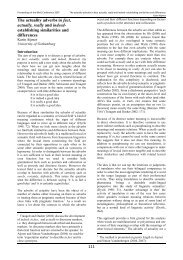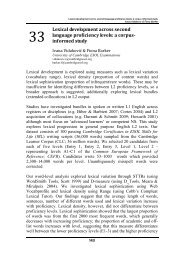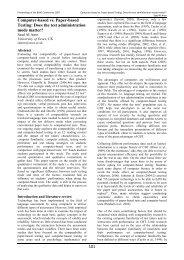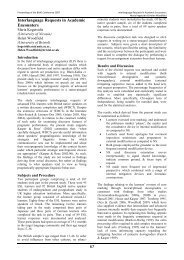Proceedings of the - British Association for Applied Linguistics
Proceedings of the - British Association for Applied Linguistics
Proceedings of the - British Association for Applied Linguistics
You also want an ePaper? Increase the reach of your titles
YUMPU automatically turns print PDFs into web optimized ePapers that Google loves.
The Impact <strong>of</strong> <strong>Applied</strong> <strong>Linguistics</strong>: <strong>Proceedings</strong> <strong>of</strong> <strong>the</strong> 44th Annual Meeting <strong>of</strong> BAAL<br />
University <strong>of</strong> <strong>the</strong> West <strong>of</strong> England<br />
L1/Level German Spanish Korean<br />
A2 x 2 x<br />
B1 2 2 2<br />
B2 2 2 2<br />
C1 x 2 x<br />
Table 12.1: Dataset<br />
The participants represent ‘average’ learners at each level and were<br />
selected from video-recorded benchmarked speaking test per<strong>for</strong>mances<br />
used <strong>for</strong> examiner training. The elicitation tasks included description <strong>of</strong> a<br />
visual task (at B1-C1) and an in<strong>for</strong>mation gap task (at A2). A 60-second<br />
speech sample per participant was analysed <strong>for</strong> this pilot study. This paper<br />
will present <strong>the</strong> preliminary findings <strong>for</strong> <strong>the</strong> 8 L1 Spanish learners <strong>of</strong><br />
English.<br />
Method<br />
The pronunciation measures under investigation were selected to be crosslinguistically<br />
valid and included:<br />
1. A set <strong>of</strong> systemic properties that differ cross-linguistically:<br />
a. Sound segments and syllable structures:<br />
English has richer and more complex inventories <strong>of</strong> sound<br />
segments and syllable structures than most o<strong>the</strong>r languages<br />
including Spanish.<br />
b. Sentence stress (accentuation) and boundary marking:<br />
Both <strong>the</strong> placement and <strong>the</strong> realisation <strong>of</strong> <strong>the</strong>se vary between<br />
languages.<br />
2. A set <strong>of</strong> rhythm metrics which reflect cross-linguistic differences in<br />
timing:<br />
Languages have different characteristic rhythms, traditionally<br />
referred to as ‘stress timing’ and ‘syllable timing’ (Pike 1945,<br />
Abercrombie 1967) due to differences in <strong>the</strong>ir phonological<br />
properties, such as syllable structure (Roach 1982, Dauer 1983,<br />
1987), and also to prosodic properties like accentuation and<br />
boundary marking (Prieto et al., in press). A number <strong>of</strong> metrics<br />
have been developed to quantify <strong>the</strong>se rhythmic differences, and<br />
<strong>the</strong>y have been successfully applied in research on child speech,<br />
clinical speech, and L2 speech (White and Mattys 2007, Payne et al.<br />
in press). In this study, <strong>the</strong> rhythm metrics V% (<strong>the</strong> proportion <strong>of</strong><br />
vocalic intervals in <strong>the</strong> utterance), Varco-V and Varco-C<br />
(variability in vocalic/consonantal interval duration), and nPVI-C<br />
68







